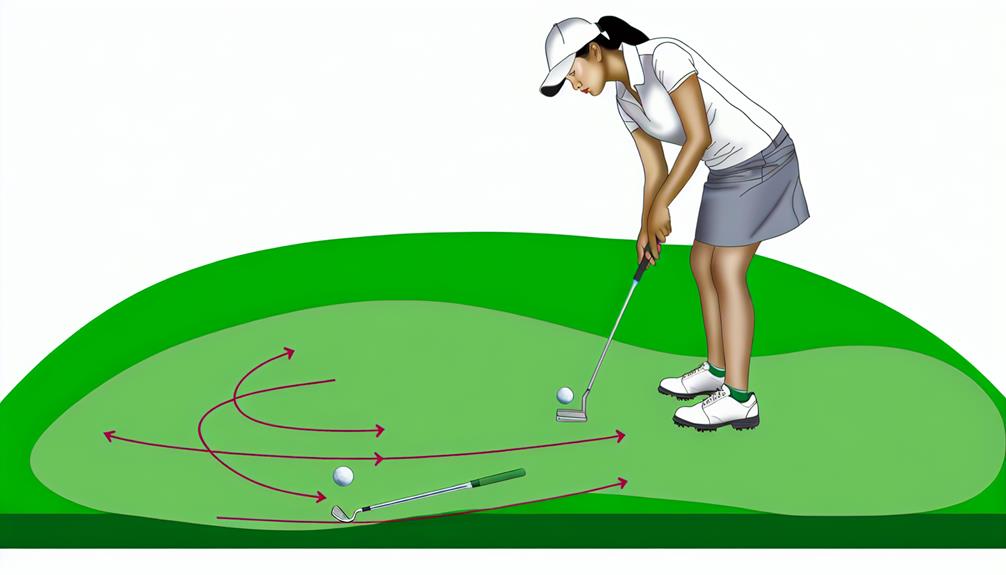Just as a sailor navigates the unpredictable waves of the open sea, you too must master the art of maneuvering your ball over the undulating landscapes of the golf course.
The terrain, with its slopes and curves, becomes a complex puzzle to solve. Some putting strategies work remarkably well on uneven terrain, while others fall short. But why is that?
By diving into the physics of the game and understanding the impact of various techniques, you'll uncover the secrets behind successful putts on uneven ground.
Brace yourself for an exploration into the science and strategy of golf!
Understanding Golf Putting Basics
To master the art of golf putting on uneven terrain, you need to grasp the fundamental elements of golf putting basics. This includes understanding how the ball behaves on different surfaces, the importance of your stance, and the technique of your swing.
Dive deep into grip techniques, one of the core skills in golf putting basics. The way you hold your club directly impacts the direction and speed of your ball. A firm, consistent grip is key to maintaining control, especially on uneven terrain. Opt for the reverse overlap or the cross-handed grip for better stability.
Understanding the ball's behavior on varied surfaces is equally crucial. The ball's speed, roll, and direction can be drastically affected by the surface type, its moisture content, and its unevenness.
Perfecting your stance is a must, too. Align your feet, hips, and shoulders parallel to the target line to improve accuracy. Lean slightly forward from your hips, keeping your weight evenly distributed.
Influence of Terrain on Putting
Now that you've got a handle on the fundamentals of putting, let's explore how the unevenness of the terrain can significantly influence your putting strategy.
Terrain texture effects are one of the key factors you need to consider. Different types of grass, soil moisture, and the presence of obstructions such as sand or water can greatly affect the roll of your ball. For instance, a rougher texture may slow down the ball, requiring more force on your stroke. Conversely, a smoother terrain might make the ball skid, demanding a lighter touch.
Slope calculation methods come into play when dealing with uneven ground. It's crucial to accurately gauge the incline or decline of the hole area. The ball's path will naturally curve towards the lowest point due to gravity, so you need to aim your putt considering this 'break'. You can use visual cues, such as the direction grass blades are leaning or the way water would flow over the terrain, to predict the slope.
There's an intricate science to adapting your putting strategy to the terrain. Mastering these aspects can give you a leg up in tackling challenging putting scenarios.
Effective Strategies for Uneven Surfaces
Mastering the greens' unpredictability, your strategy for putting on uneven surfaces should be as precise and adaptable as the terrain itself. A crucial aspect of this strategy is Slope Analysis. You must accurately judge the angle and direction of the slope. Your ball's path will be affected by gravity, forcing it to curve or slow down depending on the incline. A visual check, body alignment and practice putts can help you decipher the slope's impact.
Your strategy should also consider Grass Texture. The type, length, and health of the grass significantly affect your ball's speed and direction. For instance, longer, rougher grass slows the ball down, requiring more force. Conversely, short, smooth grass allows for faster, straighter travel. You'll need to adjust your stroke power accordingly.
Lastly, remember that the ball's roll is influenced by both the slope and grass texture. This means you'll have to integrate both factors into your strategy. Adapt your approach based on a thorough analysis of the terrain's characteristics. With practice, you'll develop an instinct for assessing these variables and making the necessary adjustments.
Case Studies of Successful Uneven Terrain Putting
Let's delve into three compelling case studies that demonstrate successful strategies for putting on uneven terrain.
In the first case, a professional golfer made substantial terrain adjustments during a championship. Instead of relying on raw power, he focused on the slope and undulations of the terrain, adjusting his speed and angle accordingly. This allowed for a more controlled putt despite the uneven ground, leading to a championship-winning shot.
The second case focuses on an amateur golfer who used a different approach. Analyzing the terrain, he noticed a subtle dip in the green. Instead of trying to fight against it, he used it to his advantage. He aimed his putt to the side of the hole, allowing the terrain to guide the ball into the hole. This unconventional strategy paid off and led to his first tournament win.
The final case analysis involves a junior golfer. Despite her inexperience, she demonstrated exceptional skill in reading the terrain. By taking her time to study the slope and texture of the green, she was able to adjust her putting technique, resulting in a remarkable long-range putt that secured her victory.
Improving Your Putting Technique on Uneven Ground
Honing your skills on uneven grounds can significantly improve your overall golf game, particularly when it comes to putting precision and control. A critical aspect of this improvement involves mastering slope calculation. This skill requires understanding how the ball's path will be affected by the terrain's gradient. It's not merely about calculating the slope's angle but also gauging the direction of the slope. By correctly determining these two factors, you can adapt your putt to meet the demands of the uneven ground.
Putt adaptation is another essential skill to develop. Here's the challenge: every putt is unique, especially on uneven terrain. You need to adjust your stance, the ball's position, and your stroke's power and direction based on the calculated slope. You're essentially modifying your putting technique to counteract the effects of the uneven surface.

